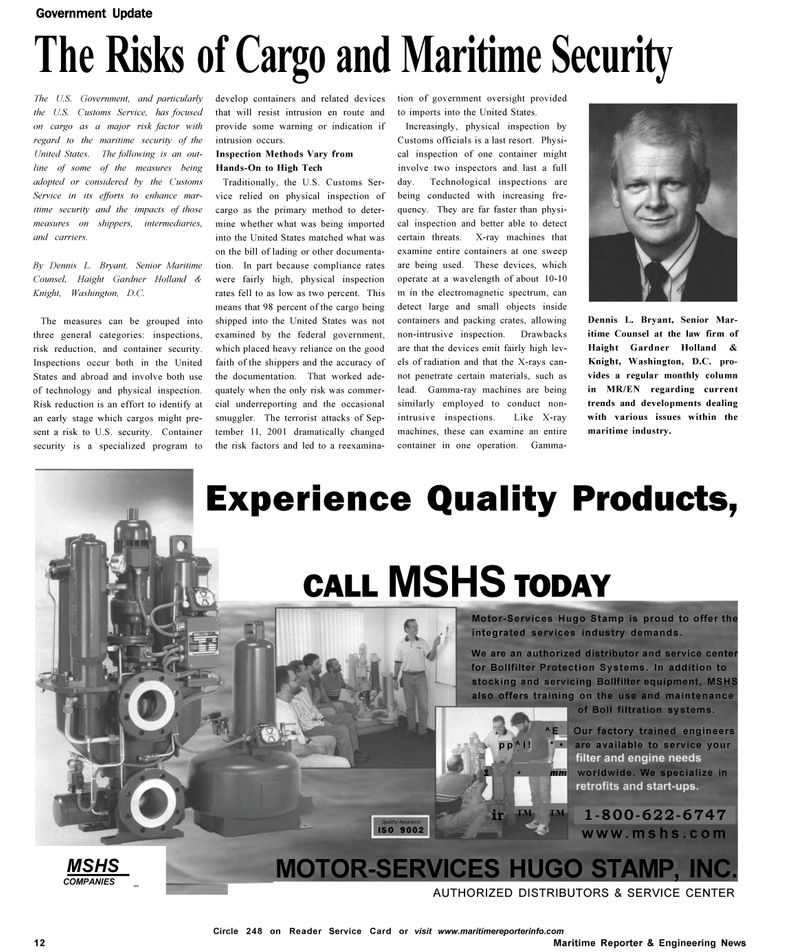
Page 12: of Maritime Reporter Magazine (October 2002)
Read this page in Pdf, Flash or Html5 edition of October 2002 Maritime Reporter Magazine
Government Update
The Risks of Cargo and Maritime Security
The U.S. Government, and particularly the U.S. Customs Service, has focused on cargo as a major risk factor with regard to the maritime security of the
United States. The following is an out- line of some of the measures being adopted or considered by the Customs
Service in its efforts to enhance mar- itime security and the impacts of those measures on shippers, intermediaries, and carriers.
By Dennis L. Bryant, Senior Maritime
Counsel, Haight Gardner Holland &
Knight, Washington, D.C.
The measures can be grouped into three general categories: inspections, risk reduction, and container security.
Inspections occur both in the United
States and abroad and involve both use of technology and physical inspection.
Risk reduction is an effort to identify at an early stage which cargos might pre- sent a risk to U.S. security. Container security is a specialized program to develop containers and related devices that will resist intrusion en route and provide some warning or indication if intrusion occurs.
Inspection Methods Vary from
Hands-On to High Tech
Traditionally, the U.S. Customs Ser- vice relied on physical inspection of cargo as the primary method to deter- mine whether what was being imported into the United States matched what was on the bill of lading or other documenta- tion. In part because compliance rates were fairly high, physical inspection rates fell to as low as two percent. This means that 98 percent of the cargo being shipped into the United States was not examined by the federal government, which placed heavy reliance on the good faith of the shippers and the accuracy of the documentation. That worked ade- quately when the only risk was commer- cial underreporting and the occasional smuggler. The terrorist attacks of Sep- tember 11, 2001 dramatically changed the risk factors and led to a reexamina- tion of government oversight provided to imports into the United States.
Increasingly, physical inspection by
Customs officials is a last resort. Physi- cal inspection of one container might involve two inspectors and last a full day. Technological inspections are being conducted with increasing fre- quency. They are far faster than physi- cal inspection and better able to detect certain threats. X-ray machines that examine entire containers at one sweep are being used. These devices, which operate at a wavelength of about 10-10 m in the electromagnetic spectrum, can detect large and small objects inside containers and packing crates, allowing non-intrusive inspection. Drawbacks are that the devices emit fairly high lev- els of radiation and that the X-rays can- not penetrate certain materials, such as lead. Gamma-ray machines are being similarly employed to conduct non- intrusive inspections. Like X-ray machines, these can examine an entire container in one operation. Gamma-
Dennis L. Bryant, Senior Mar- itime Counsel at the law firm of
Haight Gardner Holland &
Knight, Washington, D.C. pro- vides a regular monthly column in MR/EN regarding current trends and developments dealing with various issues within the maritime industry.
Quality-Assurance
Experience Quality Products,
CALL MSHS TODAY
MSHS_
COMPANIES _
ISO 9002
Motor-Services Hugo Stamp is proud to offer the integrated services industry demands.
We are an authorized distributor and service center for Bollfilter Protection Systems. In addition to stocking and servicing Bollfilter equipment, MSHS also offers training on the use and maintenance of Boll filtration systems. ^E Our factory trained engineers pp^l! * • are available to service your 1 • mm worldwide. We specialize in ir ™ ™ 1-800-622-6747 www.mshs.com
MOTOR-SERVICES HUGO STAMP, INC.
AUTHORIZED DISTRIBUTORS & SERVICE CENTER 12
Circle 248 on Reader Service Card or visit www.maritimereporterinfo.com
Maritime Reporter & Engineering News

 11
11

 13
13
